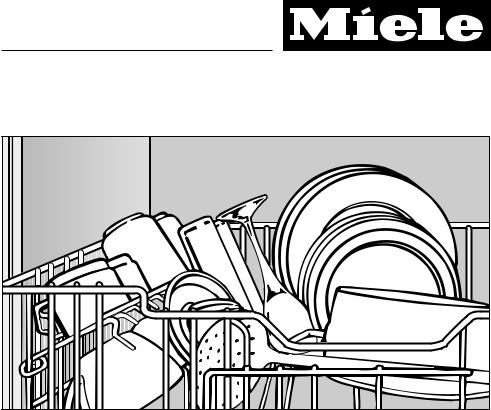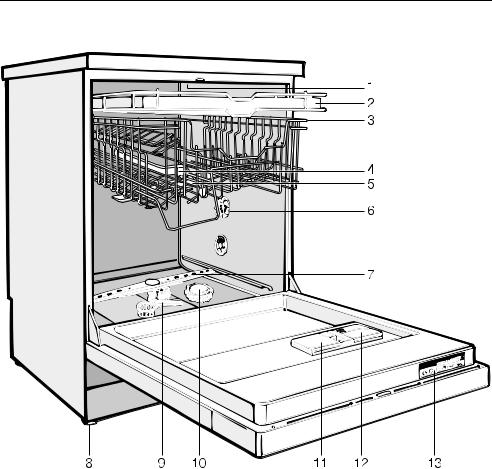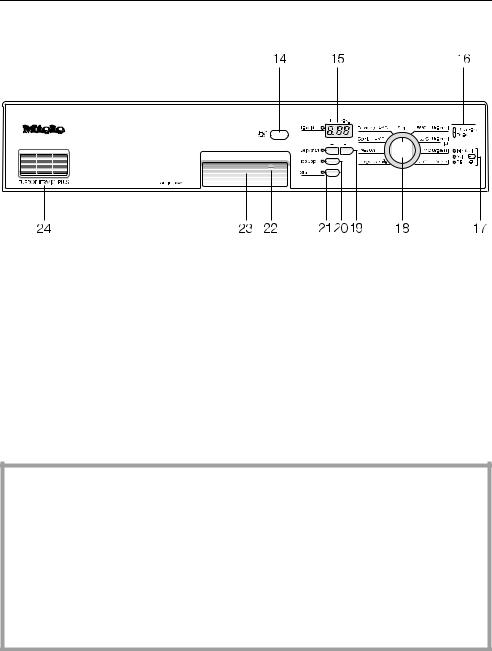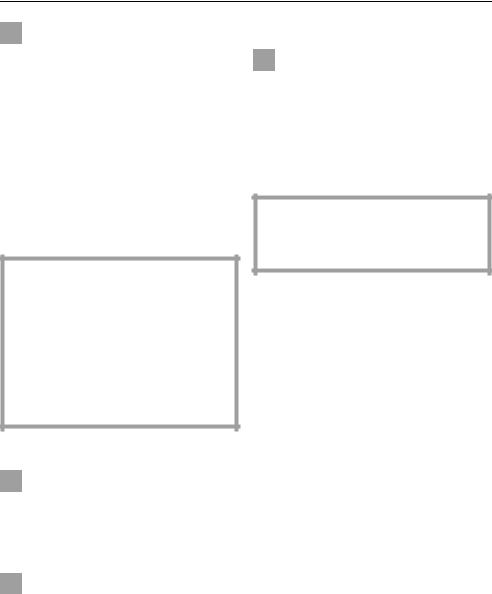Miele G674, G681, G683, G684, G881 Operating instructions
...
Operating instructions
for dishwashers
It is essential to read the operating and installation instructions before installing, commissioning or using the machine, to avoid the risk of accident or damage to the machine.
Q
M.-Nr. 05 430 280

Contents
Guide to the appliance . . . . . . . . . . . . . . . . . . . . . . . . . . . . . . . . . . . . . . . . . . . . . 4 View of the machine . . . . . . . . . . . . . . . . . . . . . . . . . . . . . . . . . . . . . . . . . . . . . . . . 4 Control panel (fascia ) . . . . . . . . . . . . . . . . . . . . . . . . . . . . . . . . . . . . . . . . . . . . . . . 5
Warning and safety instructions. . . . . . . . . . . . . . . . . . . . . . . . . . . . . . . . . . . . . . 6
Caring for the environment . . . . . . . . . . . . . . . . . . . . . . . . . . . . . . . . . . . . . . . . . 10 Disposal of the packing material . . . . . . . . . . . . . . . . . . . . . . . . . . . . . . . . . . . . . . 10 Disposal of your old appliance . . . . . . . . . . . . . . . . . . . . . . . . . . . . . . . . . . . . . . . 10 Energy saving washing . . . . . . . . . . . . . . . . . . . . . . . . . . . . . . . . . . . . . . . . . . . . . 10
Before using for the first time . . . . . . . . . . . . . . . . . . . . . . . . . . . . . . . . . . . . . . 11 Before using the machine for the first time you require . . . . . . . . . . . . . . . . . . . . . 11 To open the door . . . . . . . . . . . . . . . . . . . . . . . . . . . . . . . . . . . . . . . . . . . . . . . . . . 12 To close the door . . . . . . . . . . . . . . . . . . . . . . . . . . . . . . . . . . . . . . . . . . . . . . . . . 12 Child safety lock. . . . . . . . . . . . . . . . . . . . . . . . . . . . . . . . . . . . . . . . . . . . . . . . . . . 12 Water softener . . . . . . . . . . . . . . . . . . . . . . . . . . . . . . . . . . . . . . . . . . . . . . . . . . . . 13 Programming and setting the water hardness level . . . . . . . . . . . . . . . . . . . . . . . 14
Programming and changing the water hardness level. . . . . . . . . . . . . . . . . . . 14 Setting the water hardness level selector in the wash cabinet. . . . . . . . . . . . . 15 Filling the salt reservoir . . . . . . . . . . . . . . . . . . . . . . . . . . . . . . . . . . . . . . . . . . . . . 16 Salt indicator . . . . . . . . . . . . . . . . . . . . . . . . . . . . . . . . . . . . . . . . . . . . . . . . . . . . . 17 Rinse aid . . . . . . . . . . . . . . . . . . . . . . . . . . . . . . . . . . . . . . . . . . . . . . . . . . . . . . . . 18 Adding rinse aid. . . . . . . . . . . . . . . . . . . . . . . . . . . . . . . . . . . . . . . . . . . . . . . . . . . 18 Rinse aid indicator . . . . . . . . . . . . . . . . . . . . . . . . . . . . . . . . . . . . . . . . . . . . . . . . . 19 Setting the rinse aid dosage . . . . . . . . . . . . . . . . . . . . . . . . . . . . . . . . . . . . . . . . . 20
Loading the dishwasher . . . . . . . . . . . . . . . . . . . . . . . . . . . . . . . . . . . . . . . . . . . 21 Loading examples . . . . . . . . . . . . . . . . . . . . . . . . . . . . . . . . . . . . . . . . . . . . . . . . . 22 Upper basket . . . . . . . . . . . . . . . . . . . . . . . . . . . . . . . . . . . . . . . . . . . . . . . . . . 22 Flap up rack . . . . . . . . . . . . . . . . . . . . . . . . . . . . . . . . . . . . . . . . . . . . . . . . . . . 23 Positioning rail. . . . . . . . . . . . . . . . . . . . . . . . . . . . . . . . . . . . . . . . . . . . . . . . . . 23 Adjusting the upper basket . . . . . . . . . . . . . . . . . . . . . . . . . . . . . . . . . . . . . . . 24 Lower basket . . . . . . . . . . . . . . . . . . . . . . . . . . . . . . . . . . . . . . . . . . . . . . . . . . 25 Bottle holder . . . . . . . . . . . . . . . . . . . . . . . . . . . . . . . . . . . . . . . . . . . . . . . . . . . 26 Cutlery. . . . . . . . . . . . . . . . . . . . . . . . . . . . . . . . . . . . . . . . . . . . . . . . . . . . . . . . 26 Items not suitable for dishwashers. . . . . . . . . . . . . . . . . . . . . . . . . . . . . . . . . . . . . 29
Operating the dishwasher . . . . . . . . . . . . . . . . . . . . . . . . . . . . . . . . . . . . . . . . . 30 Adding detergent . . . . . . . . . . . . . . . . . . . . . . . . . . . . . . . . . . . . . . . . . . . . . . . . . 30 Programme selection . . . . . . . . . . . . . . . . . . . . . . . . . . . . . . . . . . . . . . . . . . . . . . 33
2

|
Contents |
Switching on . . . . . . . . . . . . . . . . . . . . . . . . . . . . . . . . . . . . . . . . . . . . |
. . . . . . . . . 34 |
Starting a programme . . . . . . . . . . . . . . . . . . . . . . . . . . . . . . . . . . . . . . |
. . . . . . . . 34 |
Programme sequence indicator lights . . . . . . . . . . . . . . . . . . . . . . . . . . |
. . . . . . . . 35 |
Time display . . . . . . . . . . . . . . . . . . . . . . . . . . . . . . . . . . . . . . . . . . . . . . |
. . . . . . . . 35 |
Light ring . . . . . . . . . . . . . . . . . . . . . . . . . . . . . . . . . . . . . . . . . . . . . . . . |
. . . . . . . . 35 |
At the end of a programme . . . . . . . . . . . . . . . . . . . . . . . . . . . . . . . . . . |
. . . . . . . . 36 |
Switching off. . . . . . . . . . . . . . . . . . . . . . . . . . . . . . . . . . . . . . . . . . . . . . |
. . . . . . . . 36 |
Interrupting a programme . . . . . . . . . . . . . . . . . . . . . . . . . . . . . . . . . . . |
. . . . . . . . 37 |
Changing a programme. . . . . . . . . . . . . . . . . . . . . . . . . . . . . . . . . . . . . |
. . . . . . . . 37 |
Additional functions . . . . . . . . . . . . . . . . . . . . . . . . . . . . . . . . . . . . . . . . |
. . . . . . . . 38 |
“Top Solo” . . . . . . . . . . . . . . . . . . . . . . . . . . . . . . . . . . . . . . . . . . . . . |
. . . . . . . . 38 |
Delay start . . . . . . . . . . . . . . . . . . . . . . . . . . . . . . . . . . . . . . . . . . . . . |
. . . . . . . . 40 |
Unloading the dishwasher . . . . . . . . . . . . . . . . . . . . . . . . . . . . . . . . . . |
. . . . . . . . 42 |
Cleaning and care . . . . . . . . . . . . . . . . . . . . . . . . . . . . . . . . . . . . . . . . |
. . . . . . . . 43 |
Cleaning the filters in the wash cabinet . . . . . . . . . . . . . . . . . . . . . . . . |
. . . . . . . . 43 |
Cleaning the spray arms . . . . . . . . . . . . . . . . . . . . . . . . . . . . . . . . . . . . |
. . . . . . . . 45 |
Cleaning the wash cabinet . . . . . . . . . . . . . . . . . . . . . . . . . . . . . . . . . . |
. . . . . . . . 46 |
Cleaning the door and the door seal . . . . . . . . . . . . . . . . . . . . . . . . . . |
. . . . . . . . 46 |
Cleaning the control panel (fascia) . . . . . . . . . . . . . . . . . . . . . . . . . . . . |
. . . . . . . . 46 |
Cleaning the door panel. . . . . . . . . . . . . . . . . . . . . . . . . . . . . . . . . . . . . |
. . . . . . . . 46 |
Problem solving guide . . . . . . . . . . . . . . . . . . . . . . . . . . . . . . . . . . . . |
. . . . . . . . 47 |
Solving problems . . . . . . . . . . . . . . . . . . . . . . . . . . . . . . . . . . . . . . . . . |
. . . . . . . . 55 |
Cleaning the water inlet filter . . . . . . . . . . . . . . . . . . . . . . . . . . . . . . . . . |
. . . . . . . . 55 |
Cleaning the drain pump and non-return valve . . . . . . . . . . . . . . . . . . |
. . . . . . . . 56 |
After sales service . . . . . . . . . . . . . . . . . . . . . . . . . . . . . . . . . . . . . . . |
. . . . . . . . 58 |
Special accessories . . . . . . . . . . . . . . . . . . . . . . . . . . . . . . . . . . . . . . |
. . . . . . . . 59 |
Comparison tests . . . . . . . . . . . . . . . . . . . . . . . . . . . . . . . . . . . . . . . . |
. . . . . . . . 60 |
Transport. . . . . . . . . . . . . . . . . . . . . . . . . . . . . . . . . . . . . . . . . . . . . . . . |
. . . . . . . . 66 |
Technical data . . . . . . . . . . . . . . . . . . . . . . . . . . . . . . . . . . . . . . . . . . . |
. . . . . . . . 67 |
Programme chart . . . . . . . . . . . . . . . . . . . . . . . . . . . . . . . . . . . . . . . . . |
. . . . . . . . 68 |
Model type G 6XX . . . . . . . . . . . . . . . . . . . . . . . . . . . . . . . . . . . . . . . . . |
. . . . . . . . 68 |
Model type G 8XX . . . . . . . . . . . . . . . . . . . . . . . . . . . . . . . . . . . . . . . . . |
. . . . . . . . 70 |
3

Guide to the appliance
View of the machine
1 |
Upper spray arm (not visible) |
8 |
Four height adjustable screw feet |
2 |
Cutlery tray |
9 |
Filter combination |
|
(depending on model) |
10 |
Salt reservoir |
|
|
||
3 |
Upper basket |
11 |
Dual compartment detergent |
|
|
||
4 |
Water feed for middle |
|
dispenser |
|
spray arm |
12 |
Rinse aid reservoir |
|
|
||
5 |
Middle spray arm |
|
(with dosage selector) |
6 |
Water hardness selector |
13 |
Data plate |
7 |
Lower spray arm |
|
|
4

Guide to the appliance
Control panel (fascia)
14 |
“On/Off” button |
20 |
“Top Solo” button |
15 |
Time display |
21 |
“Start” button |
16 |
Programme sequence display |
22 |
Child safety lock |
17 |
Check/Refill indicators |
23 |
Door release |
18 |
Selector with light ring |
24 |
Ventilation outlet for drying fan |
19 |
“Delay Start” buttons |
|
|
This instruction book applies to several different dishwasher models. These are:
The model numbers G 6 XX and G 8XX used in this book refer to the model designation specified on the data plate of the machine (and not the description on the control panel). The data plate is located at the top of the door when open.
Throughout this booklet the G 674 (SC) (i,U) to G 684 (SC) (i,U) will be referred to generally as G 6XX.
Similarly the G 881 SCi to G 884 Sci will be referred to as G 8XX.
5

Warning and safety instructions
This appliance conforms to current safety requirements. Inappropriate use can however lead to personal injury and damage to property.
Read the operating instructions carefully before starting to use this machine.This way you will avoid the risk of accidents, and damage to the machine.
Keep these instructions in a safe place for reference, and pass them on to any future user.
Appropriate usage
This dishwasher is intended exclusively for cleaning domestic croc-
kery and cutlery in a domestic household. Do not use for purposes other than those for which it was designed. Any other applications may be dangerous.
The manufacturer cannot be held responsible for any damage caused by improper use or for uses other than those for which the appliance is intended.
Delivery
A damaged appliance is dangerous. It is therefore essential to
check packaging immediately and examine the dishwasher for transport damage. Under no circumstances should you use a damaged machine.
Please ensure that the packaging material is offered for recycling.
Installation
The dishwasher must be installed and connected in compliance with
the installation instructions.
In order to ensure stability, builtunder and integrated dishwashers
must only be installed under a continuous worktop which is secured to adjacent cabinetry.
The dishwasher must not be installed under a hob unit. The high
temperatures sometimes dissipated by radiant heat could damage the dishwasher.
Do not connect the dishwasher to the mains supply until it has been
installed.
Check that the voltage, frequency and fuse rating shown on the data plate match the household mains sup-
ply.
The electrical safety of this appliance can only be guaranteed
when continuity is complete between the appliance and an effective earthing system. It is imperative that this basic safety requirement is tested and where there is any doubt the electrical system in the house is checked out by a qualified electrician.
The manufacturer cannot be held responsible for damage caused by the lack or inadequacy of an effective earthing system (electric shock, for example).
6

Warning and safety instructions
A damaged appliance is dangerous. Switch off at the mains
and call your Miele supplier or the Miele Service Department.
With the “Waterproof system” the plastic housing of the water inlet
connection contains an electrical component. The housing must therefore not be dipped in water.
Never cut the water inlet hose, even if it is too long. There are live
wires in this hose.
For safety reasons do not operate this appliance on an extension
cable. (Danger of overheating).
Daily use
Do not use solvents in the dishwasher. Danger of explosion.
Water in the dishwasher must not be used as drinking water.
Avoid inhalation of powder detergents. Dishwasher detergents con-
tain irritant or corrosive ingredients. They can cause burning in the mouth and throat if swallowed, or inhibit breathing. Consult a doctor immediately if detergent has been swallowed or inhaled.
Do not sit or lean on the opened door. This could cause the dishwasher to tip and be damaged and you
could get injured.
In an appliance with a cutlery basket (depending on model) cutlery is cleaned and dried more efficiently if
placed in the basket with the handles downwards. However, to avoid the risk of injury place cutlery with sharp points with the handles upwards.
Only use detergents formulated for domestic dishwashers. Do not use
washing-up liquid.
Only use rinse aid formulated for domestic dishwashers.
Only use special coarse grained dishwasher salt for reactivation, as
other salts may contain insoluble additives which can impair the functioning of the softener.
Plastic items which cannot withstand being washed in hot water,
such as disposable plastic containers, or plastic cutlery and crockery should not be cleaned in the dishwasher. The high temperatures in the dishwasher may cause them to melt or lose shape.
7

Warning and safety instructions
Take care on dishwashers with a visible heater element
Do not touch the heating element during or directly after the end of a
programme, you could burn yourself.
Some plastic items could melt or catch fire if they were to come into
contact with the heating element. Therefore always place plastic items or any other items which may not be completely heat resistant in the upper basket and ensure they cannot drop down onto the heater element. Any items which are too small to be lodged securely in the upper basket should not be cleaned in the dishwasher.
Safety with children
Do not let small children play with the dishwasher and its controls or operate it. There is a danger that child-
ren playing might shut themselves in the dishwasher.
Keep children away from detergents. Dishwasher detergents con-
tain irritant or corrosive ingredients. They can cause burning in the mouth and throat if swallowed, or inhibit breathing. Consult a doctor immediately if your child has swallowed or inhaled detergent.
To avoid the danger of children coming into contact with the dish-
washer detergent:
Only add detergent just before starting the programme and close the door, activating the child safety lock (depending on model).
Keep children away from the dishwasher when the door is open. There could be detergent residues in the appliance.
To ensure children do not come into contact with detergent:
For models with the “Delay start” option make sure the dispenser is dry before adding detergent. Wipe dry if necessary. Detergent will clog if poured into a damp dispenser and may not be thoroughly dispersed. If the door is open at the end of a programme, children may come into contact with this residue.
To avoid machine and material damage
Do not fill the rinse aid reservoir with powder or liquid detergent.
This will cause serious damage to the reservoir.
Inadvertently filling the salt reservoir with powder or liquid dish-
washer detergent always leads to serious damage to the water softener.
Do not use commercial or industrial detergents as these may dam-
age material and there is a risk of severe chemical reaction.
8

Warning and safety instructions
The Miele Waterproof System offers protection from water damage, provided the following conditions
are met:
–The dishwasher is correctly installed and plumbed in.
–The dishwasher is properly maintained and parts are replaced where it can be seen that this is necessary.
–The stopcock has been turned off when the machine is not used for a longer period of time (e.g. during holidays).
In countries where there are areas which may be subject to infestation by cockroaches or other vermin, pay particular attention to keeping the appliance and its surroundings in a clean condition at all times. Any damage which may be caused by cockroaches or other vermin will not be covered by the appliance guarantee.
Repairs and maintenance
Repairs may only be carried out by suitably qualified and competent
engineers in accordance with local and national safety regulations. Repairs by unqualified persons could be dangerous.
Always disconnect the appliance from the electrical supply for main-
tenance work (switch off at wall socket and remove the plug, or remove the screw out fuse in countries where this is applicable).
Disposal of your old machine
When disposing of an old dishwasher first make it unusable. Dis-
connect, cut off the cable and the plug from the cable.
Make the door lock inoperative (2 cross-slotted screws), so that children cannot accidentally shut themselves in. Make appropriate arrangements for the safe disposal of the appliance.
The manufacturer cannot be held responsible for any damage caused by non-observance of the warning and safety instructions.
9

Caring for the environment
Disposal of the packing material
The transport and protective packing has been selected from materials which are environmentally friendly for disposal and can normally be recycled. Rather than just throwing these materials away, please ensure they are offered for recycling.
Disposal of your old appliance
Old appliances contain materials which can be recycled. Please contact your local authorities or scrap merchant about potential recycling schemes, before disposing of the appliance. Ensure that the appliance presents no danger to children while being stored for disposal. See the appropriate section in the Warning and Safety instructions.
Energy saving washing
This dishwasher is exceptionally economical in its use of water and electricity. You can make the most of your appliance by following these tips:
If your household water system is suitable, this dishwasher can be connected to a hot water supply, for further economies.
Although all stages of the wash then take place with hot water, savings are made in:
–the use of primary energy
–costs
–programme running time.
If, however, your water is heated by electricity we would still recommend connection to cold water.
For most economical dishwashing make full use of the baskets without overloading the dishwasher.
Choose the programme to suit the type of crockery being washed and the degree of soiling.
The “Top Solo” function should only be selected for washing very small loads of crockery (see “Additional options”).
Select the Economy 45ºC programme for energy-saving dishwashing.
Use the correct amounts of detergent.
Use only 2/3 of the given dosage if baskets are only half full.
10

Before using for the first time
Before using the machine for the first time you require:
–approx. 2 litres of water,
–approx. 2 kg dishwasher reactivation salt,
–domestic dishwasher detergent,
–rinse aid formulated for domestic dishwashers.
Every dishwasher is tested at the factory.
There will be residual water in the machine from this test. It is not an indication that the machine has been previously used.
11

Before using for the first time
To open the door |
Child safety lock |
The yellow key for the child safety lock is on one of the spikes at the front of the upper basket.
Remove the key before switching on the dishwasher and keep it in a safe place away from the dishwasher.
Press the release catch inside the door grip and pull forward.
If the door is opened during operation all functions are automatically interrupted.
To close the door
Push the baskets right in. Lift the door and push until it clicks into position.
If you wish to prevent children opening the dishwasher door during operation use the key provided to turn the lock to the required setting.
Horizontal setting:
The door is locked.
Vertical setting:
The door can be opened.
12

Before using for the first time
Water softener
In order to achieve good cleaning results, the dishwasher needs to operate with soft water. Hard water results in the build-up of calcium deposits on crockery and in the dishwasher. Hence if mains water hardness is above 4 °d - German scale (0.7 mmol/l), the water should be softened. This takes place automatically in the integrated water softener.
–The water softener must be filled with dishwasher salt for reactivation.
–The dishwasher must be programmed to correspond to the water hardness in your area.
–Your local water authority will be able to advise you of the water hardness level in your area.
If the hardness of your local supply is constantly lower than 4 °d (0.7 mmol/l), you do not need to add dishwasher salt. The dishwasher must, however, still be programmed to correspond to the water hardness level in your area.
Where the water hardness fluctuates e.g. between 8 - 17 °d (1.4 - 3.1 mmol/l), always programme the machine to the higher value (17 °d/3.1 mmol/l in this example).
In the case of a fault, it will help the service technician if you know the hardness of your local water supply.
Enter the water hardness below:
°d
Settings
|
|
|
Value shown in |
°d |
mmol/l |
°f |
the time display |
|
|
|
|
1 |
0.2 |
2 |
1 |
2 |
0.4 |
4 |
2 |
3 |
0.5 |
5 |
3 |
4 |
0.7 |
7 |
4 |
5 |
0.9 |
9 |
5 |
6 |
1.1 |
11 |
6 |
7 |
1.3 |
13 |
7 |
8 |
1.4 |
14 |
8 |
9 |
1.6 |
16 |
9 |
10 |
1.8 |
18 |
10 |
11 |
2.0 |
20 |
11 |
12 |
2.2 |
22 |
12 |
13 |
2.3 |
23 |
13 |
14 |
2.5 |
25 |
14 |
15 |
2.7 |
27 |
15 |
16 |
2.9 |
29 |
16 |
17 |
3.1 |
31 |
17 |
18 |
3.2 |
32 |
18 |
19 |
3.4 |
34 |
19 |
20 |
3.6 |
36 |
20 |
21 |
3.8 |
38 |
21 |
22 |
4.0 |
40 |
22 |
23 |
4.1 |
41 |
23 |
24 |
4.3 |
43 |
24 |
25 |
4.5 |
45 |
25 |
26 |
4.7 |
47 |
26 |
27 |
4.9 |
49 |
27 |
28 |
5.0 |
50 |
28 |
29 |
5.2 |
52 |
29 |
30 |
5.4 |
54 |
30 |
31 |
5.6 |
56 |
31 |
32 |
5.8 |
58 |
32 |
33 |
5.9 |
59 |
33 |
34 |
6.1 |
61 |
34 |
35 |
6.3 |
63 |
35 |
36-70 |
6.5-12.6 |
65-126 |
36 |
|
|
|
|
The dishwasher is programmed at the factory for a water hardness level of 22 °d (4.0 mmol/l).
13

Before using for the first time
Programming and setting the water hardness level
The water hardness level of your water supply must be programmed into the machine using the buttons on the control panel. The water hardness level selector in the wash cabinet is then also set to the water hardness level in your area.
Programming and changing the water hardness level
The water hardness level which has been programmed into the machine can be checked and altered by using the buttons on the control panel.
Switch the appliance off with “On/Off” button.
Press $and “Start” in and whilst doing so at the same time switch the dishwasher on using the “On/Off” button.
A “P” and 2 figures will appear in the time display.
Turn the programme selector to “Universal Plus 55 °”.
The value corresponding to the programmed water hardness level e.g. “22” will appear in the time display. The water hardness level is 22 °d (4.0 mmol/l).
If the water hardness level in memory is the correct one:
Switch the appliance off with the “On/Off” button.
If you wish to programme in a different water hardness level:
Press the “Top Solo” button repeatedly until the value corresponding to your water hardness level appears in the display. This figure will be in °d. For instance if your water hardness level is 30 °d (5.4 mmol/l) then the figure “30” will show in the display.
Note:
Once the figure “36” is reached the counter returns to “1”.
Press the “Start” button.
“SP” appears in the time display.
Press the “Start” button again.
The water hardness level change is stored in memory.
The running time of the programme which the selector dial is set to is now shown in the display in hours and minutes.
The “Time left” indicator light next to the time display lights up.
Turn the programme selector to the “Stop” position.
Switch the dishwasher off with the “On/Off” button.
14

Before using for the first time
Setting the water hardness level selector in the wash cabinet
Switch the dishwasher off with the “On/Off” button.
The water hardness level selector in the wash cabinet must be set according to the following table.
Setting the selector to the correct setting will help minimise the effects of the wash process on glass surfaces. Too high a setting will lead to poor cleaning results and an increase in water spots left on crockery and cutlery.
Use a screwdriver to take the cover off the water hardness level selector in the wash cabinet.
Use a coin or screwdriver to adjust the water hardness level selector in the wash cabinet. There is a click as each setting is reached.
°d |
mmol/l |
°f |
|
Selector |
|
German |
|
|
|
|
setting |
scale |
|
|
|
|
(level) |
|
|
|
|
|
|
1- 7 |
0.2- |
1.3 |
2- |
13 |
3 |
8-10 |
1.4- |
1.8 |
14- |
18 |
2 |
11-14 |
2.0- |
2.5 |
20- |
25 |
1 |
15-70 |
2.7-12.6 |
27-126 |
0 |
||
|
|
|
|
|
|
The water hardness selector is set at the factory to setting “1”.
Example:
For a water hardness level of 6 °d. (1.1 mmol/l)
Turn the water hardness level selector to setting 3 (1 - 7 °d).
Replace the cover on the water hardness level selector.
15

Before using for the first time
Filling the salt reservoir
Important. Before filling the salt reservoir with dishwasher salt for the first time, you must fill it with approx. 2 litres of water to enable the salt to dissolve. Once the dishwasher has been used, there is always sufficient water in the reservoir.
Inadvertently filling the salt reservoir with powder or liquid dishwasher detergent always causes serious damage to the water softener. Make sure that you have picked up the right packet of dishwasher salt before filling the salt reservoir.
Please only use special coarse grained dishwasher salt for reactivation, as other salts may contain insoluble additives which can impair the functioning of the softener.
Remove the lower basket and unscrew the salt reservoir cap.
Fill the reservoir with approx. 2 litres of water (first use).
Place the funnel provided over the salt reservoir and carefully fill with salt. The salt reservoir holds approx. 2 kg of salt depending on the brand used.
As the salt reservoir is filled, displaced water will overflow.
Clean any excess salt from around the reservoir opening and then screw the cap on again firmly.
Run the Pre-wash programme immediately to remove any traces of salt water from the cabinet.
16

Before using for the first time
Salt indicator
The salt indicator light comes on to notify you that the reservoir is empty.
The reservoir should then be refilled with dishwasher salt for reactivation. ( See: Filling the salt reservoir)
After the reservoir has been filled, the water softener is automatically reactivated the next time the dishwasher is run. The salt indicator light may still be illuminated during this process. It will go out once the salt concentration has reached the correct level.
Note
If the water in your area is very soft (below 4 °d / 0.7 mmol) you do not need to add salt to the reservoir. The salt indicator light, however, will still come on. It should be ignored.
(See “After sales service” for definition of “PC”).
17

Before using for the first time
Rinse aid |
Adding rinse aid |
Rinse aid is necessary to ensure water does not cling and leave marks on crockery during the drying phase. Rinse aid is poured into the storage reservoir and the amount set is dispensed automatically.
Make sure you have added rinse aid before using the dishwasher for the first time.
Inadvertently filling the rinse aid reservoir with powder or liquid dishwasher detergent always causes serious damage to the reservoir. Only pour rinse aid formulated for domestic dishwashers into the reservoir.
Alternatively it is possible to use
–Household vinegar with a max. 5% acid content
Do not use vinegar with a higher acid content (e.g. vinegar essence 25% acid). This must not be used as its use would damage the dishwasher.
or
–Liquid citric acid up to 50% acid content. The resulting rinsing and drying quality will not, however, be as good as when rinse aid is used.
Press the button in the direction of the arrow until the flap springs open.
18

Before using for the first time
Rinse aid indicator
The Rinse aid indicator light on the fascia comes on when the rinse aid reservoir needs to be replenished.
Add rinse aid only until it is visible on the surface of the filter in the opening.
The rinse aid reservoir holds approx. 130 ml.
Close the flap firmly so that it clicks into place. Otherwise water would enter the rinse aid reservoir during a programme.
Wipe up any spilled rinse aid. This prevents over-foaming occuring during the next programme.
When the light comes on the reservoir still contains sufficient rinse aid for 2 - 3 programmes.
Add rinse aid in plenty of time.
19

Before using for the first time
Setting the rinse aid dosage
The dosage selector has settings from 1-6. It is set to 3 at the factory (see arrow). Approx. 3 ml of rinse aid are then used per programme. This is a recommended setting.
If spots appear on crockery and glassware:
Use a higher setting.
If clouding or smearing appears on crockery and glassware:
Use a lower setting.
20

Loading the dishwasher
Note
Remove coarse food residues from crockery.
There is no need to rinse items under running water.
Do not wash items soiled with ash, sand, wax, lubricating grease or paint in the dishwasher.
Ash does not dissolve and is distributed in the wash cabinet. Wax, sand, lubricating grease and paint cause damage to the dishwasher.
Crockery can be loaded anywhere in the baskets, but the following notes should be observed:
Do not place crockery and cutlery inside other pieces where they may be concealed.
Load the crockery so that water can access all surfaces. This ensures that it is properly cleaned.
Make sure that all items are securely positioned.
Hollow items such as cups, glasses, pans, etc. must be inverted in the basket.
Tall, narrow, hollow items, e.g. champagne glasses, should be placed in the centre of the basket to ensure better water coverage.
Deep-based items should be placed at an angle so that water can run off them freely.
The spray arms must not be blocked by items which are too tall or hang through the baskets.
If in doubt, test for free movement by manually rotating the spray arms.
Make sure that small items do not fall through the holders in the baskets. Small items, e.g. lids, should therefore be placed in the cutlery tray or cutlery basket.
Some foodstuffs may contain natural dyes, e.g. carrots, tomatoes or ketchup. Plastic items in the dishwasher may discolour if large quantities of these foodstuffs find their way into the appliance on the crockery. The stability of plastic items is not affected by this discolouration.
When the dishwasher is being loaded food and drink residue may drip onto the sides of the dishwasher door. These surfaces do not belong to the wash cabinet and are not accessed by water from the spray arms. Food residue should therefore be wiped away before the dishwasher door is closed.
21

Loading the dishwasher
Loading examples
Upper basket
For small, lightweight, delicate items such as cups, saucers, glasses, dessert bowls, etc.
Flat saucepans or casserole dishes can also be placed in the upper basket.
Long items such as soup ladles, mixing spoons and long knives should be placed lying down across the front of the upper basket.
Note for “Top Solo”
If a wash programme has been selected with the additional function “Top Solo”, all crockery must be loaded in the upper basket and cutlery tray (if fitted).
If your dishwasher has a cutlery basket then cutlery should be placed in the cutlery basket with plenty of space between items.
As the middle spray arms also directs water downwards, it is possible to wash lightly soiled plates (with a large diameter) and serving platters in the lower basket, however plenty of space must be left in between items. Do not wash dishes, bowls or other hollow containers when using this function.
22
